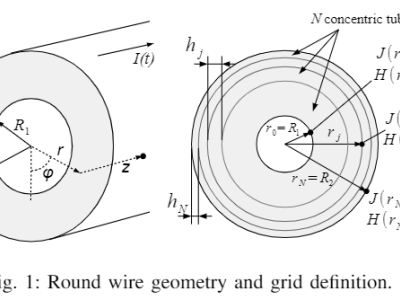Dataset Entries from this Author

Peter O. Lauritzen and Cliff L. Ma proposed an approach for creating a physical model of reverse recovery for soft recovery diodes in 1991. The current paper demonstrates how to create the proper SPICE sub-circuit using only the specifications from the diode datasheet from the manufacturer. Software for characterization tools has been developed, tested, and is now openly accessible for use
- Categories:

This work presents a sub-model of round or tubular wire with skin effect simulation. The model is based on numerical solving Maxwell's equations, using a time-domain simulator as a numerical analysis tool. The geometry of round wire is divided by the number of concentric tubes of variable thickness. Finite difference numerical equations for field and current density are adapted for the time-domain simulator. Voltage drop across the wire is calculated using current density in the outermost layer surface and external inductance of the wire.
- Categories:

The paper describes the way of extending a basicdiode SPICE model for a possibility to simulate realistic reverserecovery of power diodes. The proposed macro model uses allbasic diode model characteristics and processes the diffusioncapacitance current for adjusting reverse recovery. A Windowsapplication tool was made to simplify creating a new diode SPICEsub-model using the manufacturer data sheet or measured data.Experimental data are presented for comparison of the proposedmodel and real diode reverse recovery
- Categories:

This document presents a simple method for using time-domain simulations to extract an AC small-signal model of the power stage in a power converter. Such extraction is important for simulating feedback loop gain and assessing the stability of complex power converter topologies, such as resonant converters or converters with advanced switch control. With the proposed approach, a single time-domain simulation run is sufficient to extract the small-signal model, making the process time-efficient.
- Categories:

This research focuses on simulating a transformer
using electromagnetic field solver software: FEMM and COMSOL
Multiphysics®. These tools are used to simulate and extract
the model of a three-winding transformer. The primary objective
of the extracted model is to predict key magnetic parameters,
such as leakage and magnetizing inductances. These inductances
play a critical role in switch-mode power converter topologies,
ensuring proper operation and achieving high efficiency through
- Categories:

This research presents a multi-channel phase shift inductor-inductor-capacitor (LLC) resonant converter with a wide input and output voltage range that has been specially optimized for fuel cell applications. The worst-case minimum stack voltage and the battery voltage range were used to determine the optimal parameters of the LLC converter. The voltage gain of the converter operating at a constant power was considered, and an algorithm for such a calculation is proposed.
- Categories:
